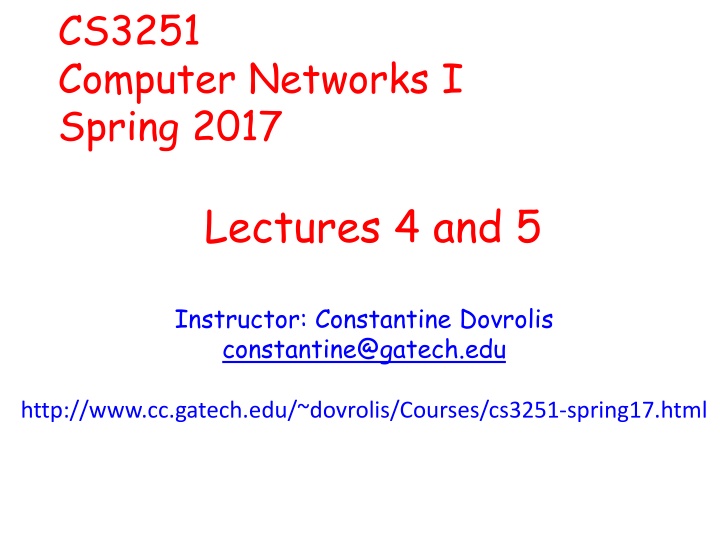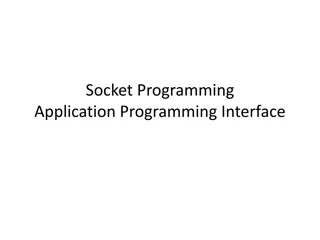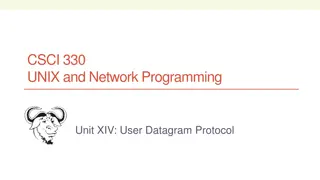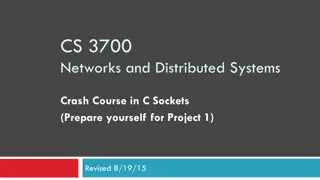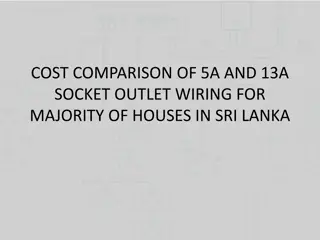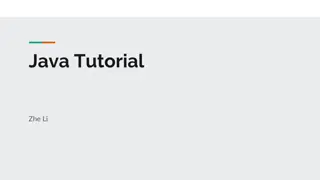Overview of Socket Programming in Computer Networks
This information presents a detailed overview of socket programming, covering topics such as Socket API, BSD Socket API, types of sockets (TCP vs UDP), and the basic functions related to I/O multiplexing. It explains the concept of sockets, their various types, their similarities, and differences, along with examples of programming interfaces and their applications in high-level networking. The information also explores the protocols and communication methods associated with different kinds of sockets in computer networks.
Download Presentation

Please find below an Image/Link to download the presentation.
The content on the website is provided AS IS for your information and personal use only. It may not be sold, licensed, or shared on other websites without obtaining consent from the author.If you encounter any issues during the download, it is possible that the publisher has removed the file from their server.
You are allowed to download the files provided on this website for personal or commercial use, subject to the condition that they are used lawfully. All files are the property of their respective owners.
The content on the website is provided AS IS for your information and personal use only. It may not be sold, licensed, or shared on other websites without obtaining consent from the author.
E N D
Presentation Transcript
CS3251 Computer Networks I Spring 2017 Lectures 4 and 5 Instructor: Constantine Dovrolis constantine@gatech.edu http://www.cc.gatech.edu/~dovrolis/Courses/cs3251-spring17.html
Socket Programming Original slides by DK Moon@Berkeley Minor edits by C.Dovrolis@GaTech
Socket API Socket API Network programming interface Application Socket API Transport TCP UDP Network IP
BSD Socket API Initially developed at UC Berkeley (1980s) Most popular network API Ported to various OSes, various languages Windows Winsock, BSD, OS X, Linux, Solaris, Socket modules in Java, Python, Perl, Similar to Unix file I/O API In the form of file descriptor (sort of handle). Can share the same read()/write()/close()system calls.
Sockets Various sockets Any similarity? Endpoint of a connection Identified by IP address and Port number Primitive to implement high-level networking interfaces e.g., Remote procedure call (RPC)
Outline Socket API motivation, background Types of sockets (TCP vs. UDP) Elementary API functions I/O multiplexing
Types of Sockets Stream socket (aka TCP) Connection-oriented Requires connection establishment & termination Reliable delivery In-order delivery Retransmission No duplicates High variance in latency Cost of the reliable service File-like interface (streaming) E.g., HTTP, SSH, FTP, Datagram socket (aka UDP) Connection-less Best-effort delivery Arbitrary order of packet delivery No retransmission Possible duplicates Low variance in latency Packet-like interface Requires packetizing E.g., DNS, VoIP, VOD, AOD,
Types of Sockets (contd) When sending Hi! and Hope you re well TCP treats them as a single bytes stream Bytes stream l l e w e p o H ! i H UDP treats them as separate messages Hope you re well Hi! 8
Types of Sockets (contd) Thus, TCP needs application-level message boundary. By carrying length in application-level header E.g. struct my_app_hdr { int length } Bytes stream l l e w o H 16 ! i H 3 9
Outline Socket API motivation, background Types of sockets (TCP vs. UDP) Elementary API functions I/O multiplexing
Host name, IP address, Port number Host name Human readable name (e.g., www.cc.gatech.edu) Variable length Could have multiple IP addresses IP version 4 address Usually represented as dotted numbers for human readability E.g., 130.207.7.210 32 bits in network byte order E.g., 1.2.3.4 => 0x04030201 Port number Identifies a service (or application) on a host E.g., TCP Port 80 => web service, UDP Port 53 => name service (DNS) 16 bit unsigned number (0~65535)
Scenario #1 TCP client-server Sequence of actions Client Server socket() bind() listen() Initialization socket() Establishment Connection connect() accept() send() or write() recv() or read() Data transfer recv() or read() send() or write() Termination Time close() close() 12
Initialization: server + client, socket() int sock = socket(AF_INET, SOCK_STREAM, 0); if (sock < 0) { perror( socket() failed ); abort(); } socket(): returns a socket descriptor AF_INET: IPv4 address family. (also OK with PF_INET) C.f. IPv6 => AF_INET6 SOCK_STREAM: streaming socket type C.f. SOCK_DGRAM perror(): prints out an error message
Error code in Unix programming extern int errno; // by #include <errno.h> Many Unix system calls and library functions set errno on errors Macros for error codes ( E + error name) EINTR, EWOULDBLOCK, EINVAL, man func_name shows possible error code for the function name Functions to convert error code into human readable msgs void perror(const char *my_str) Always looks for errno prints out my str: error code string const char *strerror(int err_code) You must provide an error code returns a string for the err_code
Initialization: server, bind() Server needs to bind a particular port number. struct sockaddr_in sin; memset(&sin, 0, sizeof(sin)); sin.sin_family = AF_INET; sin.sin_addr.s_addr = INADDR_ANY; sin.sin_port = htons(server_port); if (bind(sock, (struct sockaddr *) &sin, sizeof(sin)) < 0) { perror( bindfailed ); abort(); } bind(): binds a socket with a particular port number. Kernel remembers which process has bound which port(s). Only one process can bind a particular port number at a time. struct sockaddr_in: Ipv4 socket address structure. (c.f., struct sockaddr_in6) INADDR_ANY: If server has multiple IP addresses, binds any address. htons(): converts host byte order into network byte order.
Endianess Q) You have a 16-bit number: 0x0A0B. How is it stored in memory? Increasing address 0x0B 0x0A 0x0B Big Endian 0x0A Little Endian Increasing address Host byte order is not uniform Some machines are Big endian, others are Little endian Communicating between machines with different host byte orders is problematic Transferred $256 (0x0100), but received $1 (0x0001)
Endianness (contd) Network byte order: Big endian To avoid the endian problem We must use network byte order when sending 16bit, 32bit , 64bit numbers. Utility functions for easy conversion uint16_t htons(uint16_t host16bitvalue); uint32_t htonl(uint32_t host32bitvalue); uint16_t ntohs(uint16_t net16bitvalue); uint32_t ntohl(uint32_t net32bitvalue); Hint: h, n, s, and l stand for host byte order, network byte order, short(16bit), and long(32bit), respectively
Initialization: server, bind() Server needs to bind a particular port number. struct sockaddr_in sin; memset(&sin, 0, sizeof(sin)); sin.sin_family = AF_INET; sin.sin_addr.s_addr = INADDR_ANY; sin.sin_port = htons(server_port); if (bind(sock, (struct sockaddr *) &sin, sizeof(sin)) < 0) { perror( bindfailed ); abort(); } bind(): binds a socket with a particular port number. Kernel remembers which process has bound which port(s). Only one process can bind a particular port number at a time. struct sockaddr_in: Ipv4 socket address structure. (c.f., struct sockaddr_in6) INADDR_ANY: If server has multiple IP addresses, binds any address. htons(): converts host byte order into network byte order.
Initialization: server, listen() Socket is active, by default We need to make it passive to get connections. if (listen(sock, back_log) < 0) { perror( listenfailed ); abort(); } listen(): converts an active socket to passive back_log: connection-waiting queue size. (e.g., 32) Busy server may need a large value (e.g., 1024, )
Initialization Summary Client socket() Server socket() setsockopt(sock, SOL_SOCKET, SO_REUSEADDR) bind() listen() Pitfalls The order of the functions matter Do not forget to use htons() to handle port number
Scenario #1 TCP client-server Sequence of actions Client Server socket() bind() listen() Initialization socket() Establishment Connection connect() accept() send() or write() recv() or read() Data transfer recv() or read() send() or write() Termination Time close() close() 21
Connection Establishment (client) struct sockaddr_in sin; memset(&sin, 0 ,sizeof(sin)); sin.sin_family sin.sin_addr.s_addr = inet_addr( 128.32.132.214 ); sin.sin_port = htons(80); = AF_INET; if (connect(sock, (struct sockaddr *) &sin, sizeof(sin)) < 0) { perror( connectionfailed ); abort(); } Connect(): waits until connection establishes/fails inet_addr(): converts an IP address string into a 32bit address number (network byte order).
Connection Establishment (server) struct sockaddr_in client_sin; int addr_len = sizeof(client_sin); int client_sock = accept(listening_sock, (struct sockaddr *) &client_sin, &addr_len); if (client_sock < 0) { perror( acceptfailed ); abort(); } accept(): returns a new socket descriptor for a client connection in the connection-waiting queue. This socket descriptor is to communicate with the client The passive socket (listening_sock) is not to communicate with a client client_sin: contains client IP address and port number
Scenario #1 TCP client-server Sequence of actions Client Server socket() bind() listen() Initialization socket() Establishment Connection connect() accept() send() or write() recv() or read() Data transfer recv() or read() send() or write() Termination Time close() close() 24
Sending Data: server+client, send() char *data_addr = hello, world ; int data_len = 12; int sent_bytes = send(sock, data_addr, data_len, 0); if (sent_bytes < 0) { perror( sendfailed ); } send(): sends data, returns the number of sent bytes Also OK with write(), writev() data_addr: address of data to send data_len: size of the data With blocking sockets (default), send() blocks until it sends all the data. With non-blocking sockets, sent_bytes may not equal to data_len If kernel does not have enough space, it accepts only partial data You must retry for the unsent data
Receiving Data: server+client, recv() char buffer[4096]; int expected_data_len = sizeof(buffer); int read_bytes = recv(sock, buffer, expected_data_len, 0); if (read_bytes == 0) { // connection is closed } else if (read_bytes < 0) { // error perror( recvfailed ); } else { // OK. But no guarantee read_bytes == expected_data_len } recv(): reads bytes from the socket and returns the number of read bytes. Also OK with read() and readv() read_bytes may not equal to expected_data_len If no data is available, it blocks If only partial data is available, read_bytes < expected_data_len On socket close, expected_data_len equals to 0 (not error!) If you get only partial data, you should retry for the remaining portion.
Termination: server+client, close() // after use the socket close(sock); close(): closes the socket descriptor We cannot open files/sockets more than 1024* We must release the resource after use * Super user can overcome this constraint, but regular user cannot.
Scenario #2 UDP client-server Q) What must be changed? Client Server socket() bind() listen() Initialization socket() Establishment Connection connect() accept() send() or write() recv() or read() Data transfer recv() or read() send() or write() Termination Time close() close() 28
Scenario #2 UDP client-server A) We need a different initialization Client Server socket() bind() listen() Initialization socket() Establishment Connection connect() accept() send() or write() recv() or read() Data transfer recv() or read() send() or write() Termination Time close() close() 29
Initialization: UDP int sock = socket(AF_INET, SOCK_DGRAM, 0); if (sock < 0) { perror( socketfailed ); abort(); } UDP uses SOCK_DGRAM instead of SOCK_STREAM
Scenario #2 UDP client-server Q) What else must be changed? Client Server socket() bind() listen() Initialization socket() Establishment Connection connect() accept() send() or write() recv() or read() Data transfer recv() or read() send() or write() Termination Time close() close() 31
Scenario #2 UDP client-server A) UDP is connection-less. We remove all connection related steps. Client Server socket() bind() listen() Initialization socket() send() or write() recv() or read() Data transfer recv() or read() send() or write() Termination Time close() close() 32
Scenario #2 UDP client-server A) listen() is also related to connection. Remove it. Client Server socket() bind() Initialization socket() send() or write() recv() or read() Data transfer recv() or read() send() or write() Termination Time close() close() 33
Scenario #2 UDP client-server Q) Now it s unclear where to send packets and from where I receive! Can we solve this? Client Server socket() bind() Initialization socket() send() or write() recv() or read() Data transfer recv() or read() send() or write() Termination Time close() close() 34
Scenario #2 UDP client-server A) Give <address,port> information when sending a packet. That is, use sendto() and recvfrom() instead of send() and recv() Client Server socket() bind() Initialization socket() sendto() recvfrom() Data transfer recvfrom() sendto() Termination Time close() close() 35
Send Data Over UDP: sendto() struct sockaddr_in sin; memset(&sin, 0, sizeof(sin)); sin.sin_family = AF_INET; sin.sin_addr.s_addr = inet_addr( 128.32.132.214 ); sin.sin_port = htons(1234); sent_bytes = sendto(sock, data, data_len, 0, (struct sockaddr *) &sin, sizeof(sin)); if (sent_bytes < 0) { perror( sendtofailed ); abort(); } sendto(): sends a packet to a specific destination address and port c.f., in TCP, we do this destination setting when calling connect() As opposed to TCP, UDP packetizes data. So, sendto() sends all data or nothing.
Receive Data Over UDP: recvfrom() struct sockaddr_in sin; int sin_len; char buffer[4096]; int read_bytes = recvfrom(sock, buffer, sizeof(buffer), 0, (struct sockaddr *) &sin, &sin_len); if (read_bytes < 0) { perror( recvfromfailed ); abort(); } recvfrom(): reads bytes from the socket and sets the source information Reading 0 bytes does not mean connection closed unlike TCP. Recall UDP does not have a notion of connection .
API functions Summary TCP UDP Initialization socket(AF_INET, SOCK_STREAM, 0) setsockopt(sock, SOL_SOCKET, SO_REUSEADDR, ) bind() listen() Connection connect() accept() Data transfer send() recv() Termination close() Initialization socket(AF_INET, SOCK_DGRAM, 0) setsockopt(sock, SOL_SOCKET, SO_REUSEADDR, ) bind() No connection Data transfer sendto() recvfrom() Termination close()
Reusing the same port After TCP connection closes, waits for 2MSL, which is twice maximum segment lifetime (from 1 to 4 mins, implementation dependent). Port number cannot be reused before 2MSL But server port numbers are fixed => Must be reused Solution: Put this code before bind() int optval = 1; if (setsockopt(sock, SOL_SOCKET, SO_REUSEADDR, &optval, sizeof(optval)) < 0) { perror( reusefailed ); abort(); } setsockopt(): changes socket, protocol options. e.g., buffer size, timeout value,
Outline Socket API motivation, background Types of sockets (TCP vs. UDP) Elementary API functions I/O multiplexing
How to handle multiple inputs? Data sources Standard input (e.g., keyboard) Multiple sockets Problem: asynchronous data arrival Program does not know when it will arrive. If no data available, recv() blocks. If blocked on one source, cannot handle other sources Suppose what if a web server cannot handle multiple connections Solutions Polling using non-blocking socket Inefficient I/O multiplexing using select() simple Multithreading see example at the end of these slides
Polling using non-blocking socket This approach wastes CPU cycles int opt = fcntl(sock, F_GETFL); if (opt < 0) { perror( fcntlfailed ); abort(); } if (fcntl(sock, F_SETFL, opt | O_NONBLOCK) < 0) { perror( fcntlfailed ); abort(); } while (1) { int read_bytes = recv(sock, buffer, sizeof(buffer), 0); if (read_bytes < 0) { if (errno == EWOULDBLOCK) { // OK. Simply no data } else { perror( recvfailed ); abort(); } } Gets the socket s option Updates the socket s option with non blocking option When no data, we see EWOULDBLOCK error code.
I/O multiplexing using select() fd_set read_set; struct timeval timeout FD_ZERO(&read_set); FD_SET(sock1, &read_set); FD_SET(sock2, &read_set); timeout.tv_sec = 0; timeout.tv_usec = 5000; Initializes arguments for select() if (select(MAX(sock1, sock2) + 1, &read_set, NULL, NULL, &time_out) < 0) { perror( selectfailed ); abort(); } Pass NULL instead of &timeout if you want to wait indefinitely if (FD_ISSET(sock1, &read_set)) { // sock1 has data } if (FD_ISSET(sock2, &read_set)) { // sock2 has data } Checks I/O events.
A more elaborate example using select() See http://www.lowtek.com/sockets/select.html
An example of a multi-threaded server (using pthreads in C) See: http://www.mario- konrad.ch/blog/programming/multithread/tut orial-04.html
The bibles of advanced network programming
Tip #2 How to get IP address from host name Use gethostbyname() struct sockaddr_in sin; struct hostent *host; host = gethostbyname( www.gatech.edu ); sin.sin_addr.s_addr = *(unsigned *) host->h_addr_list[0];
Tip #3 By default, Unix terminates the process with SIGPIPE if you write to a TCP socket which has been closed by the other side. You can disable it by: signal(SIGPIPE, SIG_IGN);
Tip #4 - Structure Packing We have the following application-level packet header format (the numbers denote field size in bytes) source addr dest addr length type 2 1 4 4 So, we define the header as struct like this: struct my_pkt_hdr { unsigned short length; unsigned char type; unsigned int source_addr; unsigned int dest_addr; }; Q) Result of sizeof(struct my_pkt_hdr)?
Tip #4 - Structure Packing (contd) Compiler will try to be 4-byte aligned (on 32bit machines) To avoid the previous case, we must pack struct Windows programming style GCC style #pragma pack(push, 1) struct my_pkt_hdr { unsigned short length; unsigned char type; unsigned int source_addr; unsigned int dest_addr; }; #pragma pack(pop) struct my_pkt_hdr { unsigned short length; unsigned char type; unsigned int source_addr; unsigned int dest_addr; } __attribute__((packed)); OR
